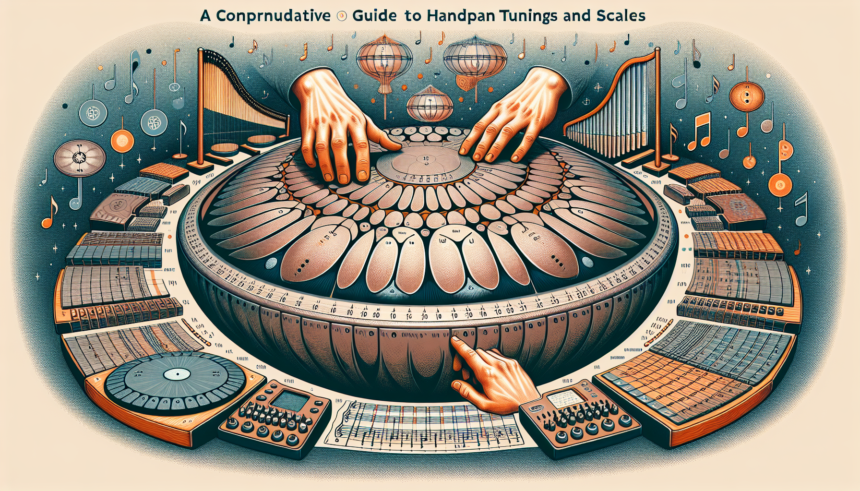Introduction
The handpan is a relatively new musical instrument, known for its unique, ethereal sound. Originating in the early 21st century, it has captivated musicians and enthusiasts worldwide. One of the defining features of a handpan is its tuning and the various scales that it can incorporate. Understanding these can be pivotal for anyone who wishes to master the instrument or even just appreciate its music more deeply. This guide delves into the most popular handpan tunings and scales, providing an in-depth look at what makes each one unique, how to recognize them, and how they influence the music produced.
What is a Handpan?
A handpan is a percussion instrument that consists of two metal shells glued together to form a hollow, resonant cavity. The top shell, called the “ding” side, has a central note, the ding, along with several tone fields arranged in a circle around it. The bottom shell typically has a smooth, rounded surface with a hole at the bottom, known as the gu.
The sound of the handpan is produced by striking the tone fields with the hands and fingers. Each tone field is meticulously tuned to a specific frequency, creating a rich, harmonic overtone when played. The handpan’s structure and tuning offer a vast array of melodic possibilities, making it an incredibly versatile instrument.
Understanding Handpan Tunings
Standard Tuning
Typically, handpans are tuned to a specific scale, which can be major, minor, or one of the many exotic scales available globally. The tuning process is an intricate art, often requiring the skill of an experienced tuner to ensure optimal sound quality. Standard tunings usually include eight or nine notes: the central ding and seven or eight other tone fields. The notes are arranged in a way that allows for easy scalability and straightforward melodies.
Alternate Tunings
Some handpans are tuned to alternate or microtonal scales, providing a broader range of musical possibilities. These tunings might not conform to traditional Western scales, offering musicians unique and often culturally diverse sounds. Examples include scale tunings that reflect Arabic, Indian, or other non-Western musical traditions.
Popular Handpan Scales
D Dorian
The D Dorian scale is one of the most popular choices for handpan tuning. It has a reflective and somewhat melancholic character that appeals to many musicians. The scale consists of the notes D, E, F, G, A, B, C, and D. The balanced tonal quality and the straightforward arrangement of notes make it accessible to beginners while still offering depth for more advanced players.
Integrating Other Modal Scales
Beyond Dorian, handpans are often tuned to other modal scales such as Mixolydian, Aeolian, and Phrygian. Each of these scales has its distinctive mood:
- Mixolydian: Known for its bright and uplifting sound, the Mixolydian scale is often used in folk and rock music. The standard handpan tuning for this scale includes the notes C, D, E, F, G, A, and Bb.
- Aeolian: The Aeolian mode, also known as the natural minor, is dark and introspective. Commonly, it might be found in A Aeolian on the handpan, featuring A, B, C, D, E, F, and G.
- Phrygian: The Phrygian scale has an exotic, somewhat Spanish flavor. One might encounter a scale like E Phrygian on the handpan, with E, F, G, A, B, C, and D as its notes.
Steps to Choose the Right Scale for You
Selecting the right handpan scale depends on your musical goals, personal preference, and playing context. Here are some steps to guide you:
Step 1: Identify Your Musical Interests
Consider what types of music you enjoy and aspire to play. For example, if you are drawn to meditative or ambient music, you might prefer scales like D Dorian or C Minor. On the other hand, if you enjoy more rhythmic or folk-based music, a Mixolydian or Pentatonic scale could be more appropriate.
Step 2: Test Different Scales
Find opportunities to listen to or play handpans tuned to various scales. This hands-on experience can provide a better sense of which scales resonate with you. Attending handpan festivals or visiting stores that sell handpans can be particularly helpful.
Step 3: Assess Your Skill Level
Beginners might find it easier to start with more straightforward, widely-used scales such as D Dorian or G Major. More experienced players may wish to explore complex or exotic scales to add greater diversity to their sound palette.
Step 4: Consider Your Playing Context
Think about where and how you will be playing your handpan. If you often play solo, a scale that offers a broad range of moods and tones might be ideal. If you frequently collaborate with other musicians, consider choosing a scale that complements the instruments they play.
Conclusion
The handpan is a captivating instrument with a rich variety of tones and scales. Whether you are a beginner or an experienced musician, understanding the different tunings and scales can significantly enhance your handpan journey. By carefully choosing the right scale based on your musical interests, testing various options, assessing your skill level, and considering your playing context, you can find the perfect handpan to suit your needs. Ultimately, the goal is to connect more deeply with the music and express yourself more fully through this magical instrument.
Frequently Asked Questions (FAQs)
1. What is the most commonly used scale for beginners?
The D Dorian scale is highly recommended for beginners due to its accessible and balanced tonal quality. It allows for straightforward melodies and harmonies, making it easier for new players to create pleasing music.
2. How do I care for my handpan to maintain its tuning?
Handpan maintenance involves regular cleaning with a soft cloth to remove fingerprints and oils. Occasionally, use a light, non-abrasive oil to prevent rust. Avoid extreme temperatures and humidity changes, as these can affect the tuning.
3. Can I retune my handpan myself?
Retuning a handpan is a delicate process that typically requires professional expertise. While minor adjustments might be possible for experienced players, it’s generally advised to seek out a skilled tuner for significant retuning work.
4. Are there handpans with more than nine notes?
Yes, there are handpans with extended note ranges, including models with up to 12 or more notes. These provide additional melodic possibilities but might require more advanced playing techniques.
5. What makes a handpan different from other steel drum instruments?
Handpans produce a unique, resonant sound that is richer in harmonic overtones compared to traditional steelpan or steel drum instruments. Their construction and tuning are designed to create a versatile melodic and rhythmic experience, often evoking deeper emotional responses from listeners and players alike.





